Editor’s note: Thanks to our friends at Catholic Relief Services for sharing this important update. To donate or to learn how you can support CRS’ emergency response in this region or around the world, visit CRS.org. LMH
Good News for a Change: Catholic Relief Services Reports Progress in Humanitarian Aid for 2012
In today’s world, bad news about poverty, disease and disaster abounds. In the spirit of Thanksgiving, Catholic Relief Services offers another perspective. Good News – For a Change highlights major strides in the fight against global poverty that are making a real difference in people’s lives.
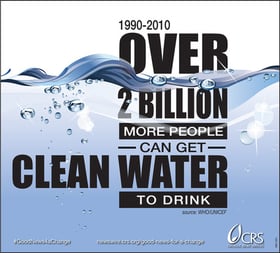 More Access to Clean Water
More Access to Clean Water
Water-borne diseases are endemic in the developing world and are a leading cause of death for children. Many people in poor, rural communities, mainly women and children, must walk miles to fetch water from sources that are often contaminated by fecal coliform bacteria. But focused development work has made a dent in addressing this problem. A March 2012 report issued jointly by UNICEF and the World Health Organization (WHO) said that the world met the Millennium Development Goal (MDG) target of cutting in half the proportion of people without sustainable access to safe drinking water, well in advance of the MDG 2015 deadline. Between 1990 and 2010, over two billion people gained access to improved drinking water sources, such as piped supplies and protected wells. This improves health and also cuts down on those long walks, allowing more children to attend school. But the report warns that victory cannot yet be declared. At least 11% of the world’s population–783 million people–are still without access to safe drinking water, and billions are without sanitation facilities.
Read how CRS has helped bring clean water to people around the world.
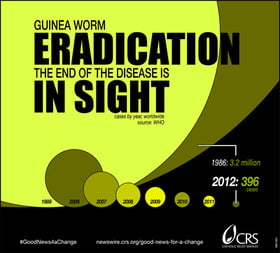 Guinea Worm Disease Nearly Eradicated
Guinea Worm Disease Nearly Eradicated
Guinea worm, an infectious parasitic disease caused by a worm that migrates through a victim’s subcutaneous tissue, has plagued the world for thousands of years. But now, the World Health Organization reports that guinea worm disease (Dracunculiasis) is on the verge of eradication. The U.N. agency says fewer than 400 cases now exist in just four African countries (about 99% of transmission is occurring in South Sudan). With continued eradication programs, it will soon become only the second disease, after smallpox, to be wiped off the face of the earth. There were an estimated 3.5 million cases of guinea worm in 1986, 892,055 cases in 1989 and 1,058 in 2011.
Read how CRS has helped reduce guinea worm disease.
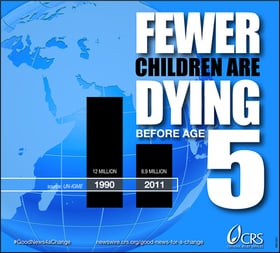 Child Survival Improving
Child Survival Improving
The mortality rate of children under five years old has long been a key indicator of a country’s level of poverty. There are still way too many children dying of preventable diseases and malnutrition. But the good news is that the trend is headed in the right direction. The most recent annual report by the UN Interagency Group for Child Mortality Estimation (UN-IGME) shows that in 2011, an estimated 6.9 million children died before their fifth birthday, compared to around 12 million in 1990. Rates of child mortality have fallen in all regions of the world in the last two decades – down by at least 50% in eastern Asia, northern Africa, Latin America and the Caribbean, south-eastern Asia and western Asia. And progress is accelerating: between 2000 and 2011, the annual rate of reduction in the global underfive mortality rate jumped to 3.2%, up from 1.8% in 1990-2000. Sub-Saharan Africa, the region with the greatest challenge in child survival, doubled its rate of reduction, from 1.5% per year in 1990-2010 to 3.1% in 2000-2011.
Read how CRS has helped reduce the child mortality rate.
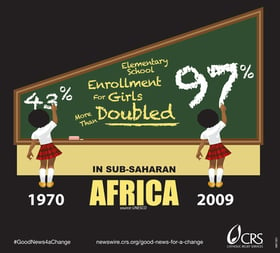 Girls Education on the Rise
Girls Education on the Rise
The courage of Malala, the 15-year-old education advocate who was recently shot on a school bus in Pakistan, highlighted how precious and precarious the opportunity for education is for so many girls around the world. But the data is clear that when girls are able to go to school, the quality of life for them and their future families rises considerably. The Good News: More girls around the world are attending school and advancing further than ever before. According to the World Development Report 2012: Gender Equality and Development: “…low- and middle-income countries have seen unprecedented gains in outcomes for women, both in absolute terms and relative to men. More women are literate and educated than ever before, and the education gap with men has shrunk dramatically. For younger cohorts, the gender gap in primary education enrollments has practically disappeared, and the gains in secondary and higher education have been enormous.”
Read how CRS helped increase the number of girls in schools.
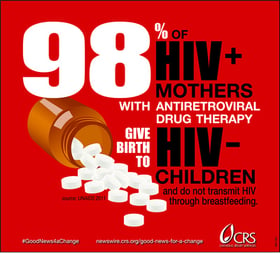 Preventing Transmission of HIV from Mother to Child
Preventing Transmission of HIV from Mother to Child
Mothers can transmit HIV to their children during pregnancy, labor, delivery or breastfeeding, a tragic beginning for a new life. Infants and children with HIV, many of whom are born into poverty, face a bleak future. The good news is that we know how to prevent this. There are effective ways, with the use of antiretroviral drug therapy and related medical care, to prevent the transmission of HIV from mother to child in as many as 98% of cases. The bad news is that without this treatment, only 55-85% of infants born to HIV-positive mothers are HIV-negative. The numbers show how much has been accomplished, but at the same time that there is much work ahead. In 2011, 57% of the estimated 1.5 million pregnant women living with HIV in low- and middle-income countries received effective antiretroviral drugs to avoid transmission to their child, an increase of nearly 10% in just one year. Around 330,000 children were newly infected with HIV in 2011, 24% lower than the number of children newly infected in 2009.
Read how CRS has helped prevent mother to child transmission of HIV.
CATHOLIC RELIEF SERVICES is the official international humanitarian agency of the Catholic community in the United States. The agency alleviates suffering and provides assistance to people in need in nearly 100 countries, without regard to race, religion or nationality. For more information, please visit crs.org or crsespanol.
About the Author

Guest
We welcome guest contributors who graciously volunteer their writing for our readers. Please support our guest writers by visiting their sites, purchasing their work, and leaving comments to thank them for sharing their gifts here on CatholicMom.com. To inquire about serving as a guest contributor, contact editor@CatholicMom.com.


.png?width=1806&height=731&name=CatholicMom_hcfm_logo1_pos_871c_2728c%20(002).png)
Comments